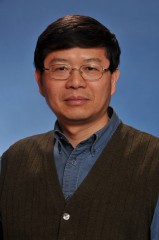Dec 9 2014
A team led by the University of Oklahoma professor who invented the interband cascade laser has reached a major milestone in the development of interband cascade lasers by creating a robust technology that operates at room temperature and works continuously—an important component for building practical systems.
 Rui Q. Yang, professor of electrical and computer engineering in the OU College of Engineering
Rui Q. Yang, professor of electrical and computer engineering in the OU College of Engineering
Rui Q. Yang, professor of electrical and computer engineering in the OU College of Engineering, proposed the concept for interband cascade lasers 20 years ago. He continues to perfect the technology for use in multiple applications, such as detecting pipeline leaks, finding new oil and gas wells and in the NASA Mars rover Curiosity.
At OU, Yang’s research group collaborates with Professors Matthew B. Johnson and Michael B. Santos and their research groups in the Homer L. Dodge Department of Physics and Astronomy in the OU College of Arts and Sciences. This latest development of room-temperature and continuous wave interband cascade lasers was a result of their collaboration with J. Gupta and colleagues at the National Research Council in Canada.
“Like a waterfall that cascades from level to level gaining energy with each step, interband cascade lasers are energy-efficient mid-infrared semiconductor laser sources for sensing chemicals in a number of applications,” says Yang. “The latest continuous wave interband cascade laser operates at room temperature yielding a more efficient product.”
Though small, the mid-infrared laser market is growing four times faster than the laser market as a whole, according to market analyst Strategies Unlimited. Yang owns four patents on interband cascade lasers and related devices with interest in assisting the technology transfer and commercialization of these semiconductor device components.
Before joining the OU College of Engineering in 2007, Yang worked for NASA’s Jet Propulsion Laboratory at the California Institute of Technology in Pasadena, Calif. He led the research and development of an interband cascade laser used to support missions to Mars. Yang continues to collaborate with NASA, Sandia National Laboratory and others on his research.